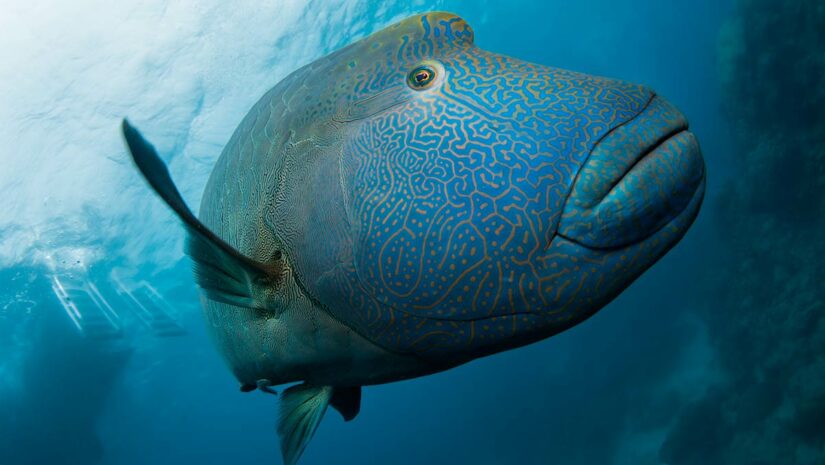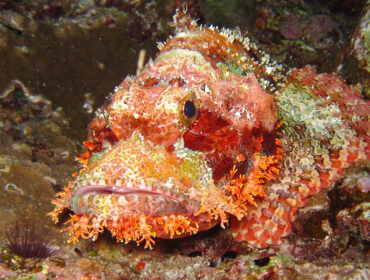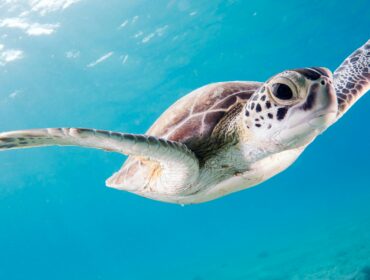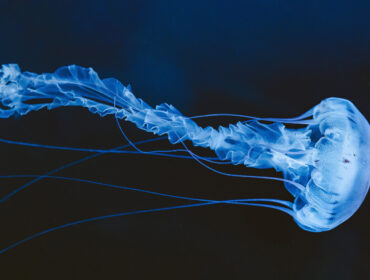Divers have been frequenting the coasts of eastern Africa, Japan, New Caledonia, and several other regions for a specific reason: to swim with the sizable sea creature known as the Napoleon wrasse, also called Maori wrasse or humphead wrasse. In some regions, they are known to be quite receptive to humans, looking to form bonds with individual divers. Inhabiting seas down to 300 feet beneath the surface, the Napoleon wrasse is easy to recognize with their beautiful colors and patterns, not to mention their immense size for being a reef-dwelling fish — weighing up to 440 lbs. Before swimming with this fish, there is a lot of information for divers to know.
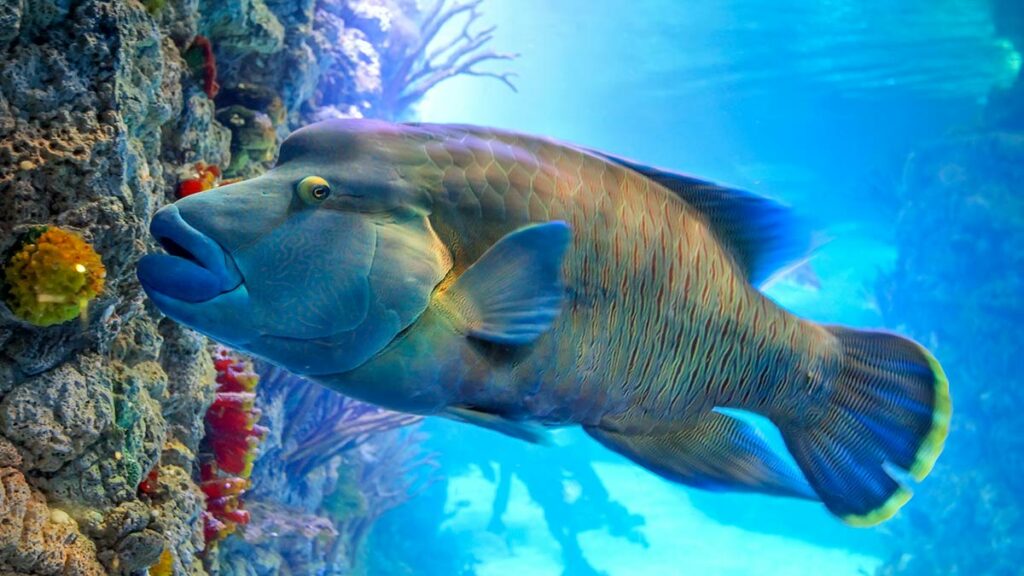
What is the Napoleon Wrasse?
Scientifically known as Cheilinus undulatus, the Napoleon fish is exquisitely bright, and recognized as the biggest of the wrasse family. The moniker Napoleon comes from a hump on its forehead and fleshy lips, which makes it appear to be wearing a Napoleon hat. Males are colored in shades ranging from bright blue-green to a deeper purple-blue tone. Young males can be distinguished by two black lines running behind their eyes, while older males have a black stripe along each side of their body. Females of this beautiful species feature gorgeous shades of red-orange, with some displaying white underbellies.
Characteristics
Not only the largest of the wrasses, it is also one of the largest reef fish. It can grow to a length of 7 feet and weigh as much as 420 pounds. However, most males grow to an average length of 6 feet, with females being much smaller at 3 feet. Despite its enormous size, it is easily scared off.
Habitat
It is most often found on the steep outer reef slopes and lagoon reefs of the Red Sea, Indian Ocean, and Pacific Ocean. It can be seen roaming the reef during the day and settling in a reef cave by night.
Diet
The Napoleon wrasse spends most of the day feeding on shellfish, starfish, sea urchins, boxfish, crabs, and other small fish. They are also known to feed on coral by snapping at it and crushing it up with their teeth. When night falls, the fish rest in the upper areas of lagoon pinnacles, caves, steep ledges, or coral reef slopes.
Behavior
Many seasoned divers claim to be struck by their high intelligence upon gazing into their inquisitive eyes. Like dogs, the Napoleon wrasse seems to revel in the presence of human contact and is commonly known to brush up against divers. They are known to get attached to divers and can often recognize their favorite diver and approach to be stroked, often nudging the diver when it wants to be petted.
With their worldwide numbers diminishing due to widespread overfishing, the Napoleon wrasse is a sea creature to be treasured and protected before they disappear from our oceans for good.
Predator Behavior
An adept predator, it has a rare immunity to toxic sea creatures and often preys on them.
Reproductivity
An adult Napoleon wrasse has the remarkable ability to change its sex. Born with both male and female sex organs, most changes occur from female to male. This usually happens when a dominant male dies. A larger female will then turn into a male to ensure the survival of the species.
Life Span
One of the more interesting facts about them is their long lifespan, often living up to 30 years and reaching sexual maturity only after 5-7 years. This, however, means that they have a very slow breeding rate, which has caused their numbers to dwindle over the years, primarily due to overfishing and reef destruction. Napoleon Wrasse is now a protected species of fish in several parts of the world and found only in large numbers in the Red Sea, the coast of East Africa, and the Indo-Pacific.
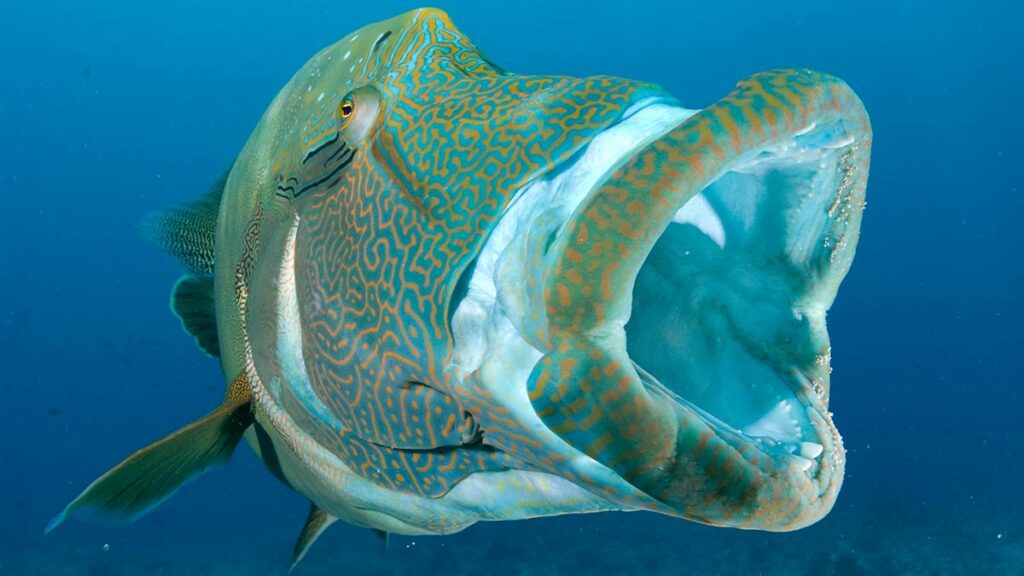
Swimming and Scuba Diving with Napoleon Wrasse
For avid underwater enthusiasts seeking awe-inspiring encounters, the Napoleon Wrasse beckons with its enchanting presence. Several pristine dive locations around the world offer the opportunity to swim alongside these majestic creatures, creating unforgettable moments for scuba divers and snorkelers alike.
Coral Triangle
Embark on a journey to the renowned Coral Triangle, a biodiversity hotspot nestled in the tropical waters of Southeast Asia. Destinations like Indonesia, Malaysia, and the Philippines boast vibrant coral reefs teeming with marine life, including the impressive Napoleon Wrasse. Dive into the crystal-clear waters of Raja Ampat or Tubbataha Reefs Natural Park for a chance to witness these magnificent fish gliding through the coral gardens.
The Great Barrier Reef
Explore the world’s largest coral reef system, the Great Barrier Reef, located off the coast of Queensland, Australia. Snorkelers and scuba divers can encounter Napoleon Wrasse in various sections of this UNESCO World Heritage site, where the dazzling colors of the fish complement the vibrant coral formations. Witness their solitary grace against the backdrop of one of the most diverse marine ecosystems on the planet.
Palau
The pristine waters of Palau, nestled in the western Pacific Ocean, offer an unparalleled diving experience. Napoleon Wrasse is frequently spotted in the famed Blue Corner, where swift currents bring nutrient-rich waters, attracting an abundance of marine life. Divers can marvel at the interaction between these magnificent fish and the diverse array of coral and reef inhabitants.
Maldives
Venture into the Maldives, a tropical paradise comprising coral atolls in the Indian Ocean. Dive sites like Maaya Thila and Fish Head provide opportunities to encounter Napoleon Wrasse against the backdrop of vibrant coral walls and bustling reef life. The Maldives offers a serene setting for underwater enthusiasts to witness the beauty of these iconic creatures.
Seychelles
The Seychelles archipelago, situated in the Indian Ocean, is another idyllic destination for those seeking encounters with Napoleon Wrasse. Explore the granite rock formations and coral reefs surrounding the islands, where these gentle giants gracefully navigate the underwater landscape. Sites like Aldabra Atoll and Amirantes Bank promise enchanting dives with these remarkable fish.
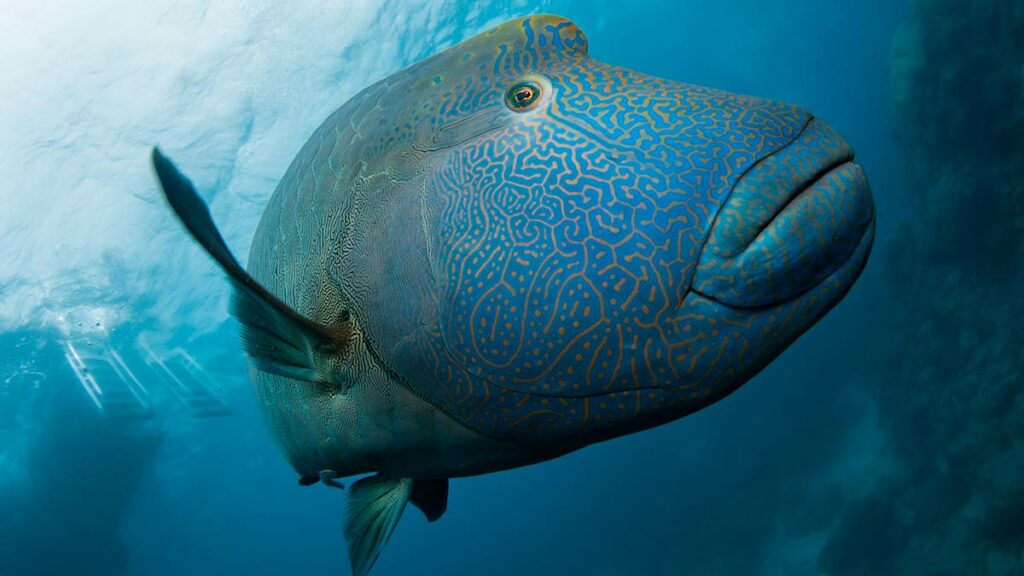
Napoleon Wrasse: Frequently Asked Questions
The Napoleon Wrasse, also known as the humphead wrasse, is renowned for its majestic and distinctive appearance. Its sheer size, vibrant colors, and the notable hump on its forehead make it a captivating species for scuba divers and marine enthusiasts. Beyond their physical allure, they are noteworthy for their solitary behavior and their crucial role in maintaining the balance of coral reef ecosystems.
The endangerment of the Napoleon Wrasse can be primarily attributed to overfishing and illegal trade. Unfortunately, its large size and unique features have made it a target for the aquarium trade and traditional Chinese medicine. The slow reproductive rate and solitary nature of the Napoleon Wrasse exacerbate the impact of overharvesting, contributing to its vulnerable conservation status.
While the Napoleon Wrasse is indeed considered a delicacy in some regions, its consumption raises concerns about the sustainability of its population. Due to its slow growth and low reproductive rate, the demand for Napoleon Wrasse in the culinary industry has contributed to its declining numbers. Responsible seafood choices and conservation efforts are crucial to ensure the long-term survival of this remarkable species.
While the Napoleon Wrasse is a formidable and large fish, it is not immune to predation. Sharks, significantly larger species, may prey on Napoleon Wrasse, particularly juveniles or individuals weakened by injury or illness. Despite its size, the Napoleon Wrasse plays a vital role in the ecosystem, and its interactions with predators are essential for maintaining a balanced and healthy marine environment.

